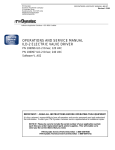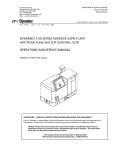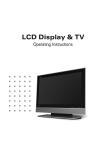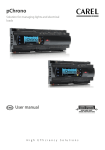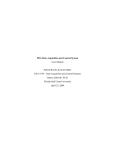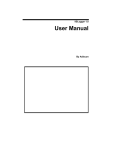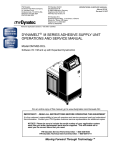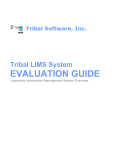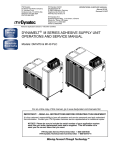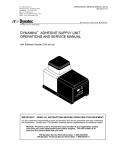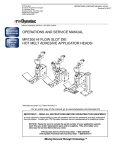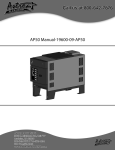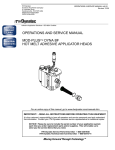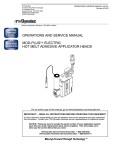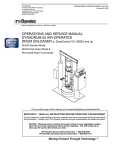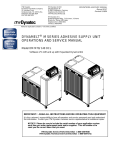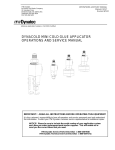Download OPERATIONS AND SERVICE MANUAL BF MICRO ADHESIVE
Transcript
ITW Dynatec An Illinois Tool Works Company 31 Volunteer Drive Hendersonville, TN 37075 USA Telephone 615.824.3634 FAX 615.264.5222 OPERATIONS & SERVICE MANUAL #40-44 Revised 12/66 Adhesive Application Solutions · ISO 9001 Certified OPERATIONS AND SERVICE MANUAL BF MICRO ADHESIVE APPLICATOR with MICRO OPTIMA MODULE HOT MELT ADHESIVE APPLICATOR IMPORTANT ! - READ ALL INSTRUCTIONS BEFORE OPERATING THIS EQUIPMENT It is the customer’s responsibility to have all operators and service personnel read and understand this information. Contact your ITW Dynatec customer service representative for additional copies. NOTICE! Please be sure to include the serial number of your application system each time you order replacement parts and/or supplies. This will enable us to send you the correct items that you need. ITW Dynatec Service Parts Direct Dial: 1-800-538-9540 ITW Dynatec Technical Service Direct Dial: 1-800-654-6711 ITW Dynatec c. 2002 BF MICRO APPLICATOR Manual #40-44 Revised 8/02 SAFETY INSTRUCTIONS GENERAL CONSIDERATIONS SERVICING EQUIPMENT 1. Read and follow these instructions. Failure to do this could result in severe personal injury or death. 1. Only trained personnel are to operate and service this equipment. 2. 2. Additional safety instructions and/ or symbols are located throughout this manual. They serve to warn maintenance personnel and operators about potentially hazardous situations. Never service or clean equipment while it is in motion. 3. Inspect the machine for unsafe conditions daily and replace all worn or defective parts. 4. Keep work area uncluttered and well lit. 5. All covers and guards must be in place before operating this equipment. For precautions and definitions of safety symbols, refer to the Safety Chapter of the service manual. Shut off the equipment and lock out all input power at the source before attempting any maintenance. 3. Follow the maintenance and service instructions in the manual. SIGNS 1. Read and obey all of the warning labels, signs and caution statements on the equipment. 2. Do not remove or deface any of the warning labels, signs and caution statements on the equipment. 3. Replace any warning labels, signs and caution statements which have been removed or defaced. Replacements are available from ITW Dynatec. ADDITIONAL CONSIDERATIONS ITW Dynatec An Illinois Tool Works Company Adhesive Application Solutions 1. To ensure proper operation of the equipment, use specified electrical and/ or air supply sources. 2. Do not attempt to alter the design of the equipment unless written approval is received from ITW Dynatec. 3. Keep all manuals readily accessible at all times and refer to it often for the best performance from your equipment. Page iii Revised 6/03 ITW Dynatec c. 2002 BF MICRO APPLICATOR Manual #40-44 TABLE OF CONTENTS Chapter - Page # Chapter 1 Safety Precautions Chapter 2 Description & Specifications Description . . . . . . . . . . . . . . . . . . . . . . . . . . . . . . . . . . . . . . . . . . . . . . . . . . . . . . . . . . . . . . . . . . . . 2-1 Specifications . . . . . . . . . . . . . . . . . . . . . . . . . . . . . . . . . . . . . . . . . . . . . . . . . . . . . . . . . . . . . . . . . . 2-2 Dimensions . . . . . . . . . . . . . . . . . . . . . . . . . . . . . . . . . . . . . . . . . . . . . . . . . . . . . . . . . . . . . . . . . . . . 2-3 Chapter 3 Installation & Start Up Handling and Shipping . . . . . . . . . . . . . . . . . . . . . . . . . . . . . . . . . . . . . . . . . . . . . . . . . . . . . . . . . . . 3-1 Service Requirements . . . . . . . . . . . . . . . . . . . . . . . . . . . . . . . . . . . . . . . . . . . . . . . . . . . . . . . . . . . . 3-1 Installation Instructions . . . . . . . . . . . . . . . . . . . . . . . . . . . . . . . . . . . . . . . . . . . . . . . . . . . . . . . . . . 3-1 Chapter 4 Maintenence Maintenence Schedule . . . . . . . . . . . . . . . . . . . . . . . . . . . . . . . . . . . . . . . . . . . . . . . . . . . . . . . . . . . Adhesive Pressure Relief . . . . . . . . . . . . . . . . . . . . . . . . . . . . . . . . . . . . . . . . . . . . . . . . . . . . . . . . . Replacement of the Built-in Filter . . . . . . . . . . . . . . . . . . . . . . . . . . . . . . . . . . . . . . . . . . . . . . . . . . Module Maintenance . . . . . . . . . . . . . . . . . . . . . . . . . . . . . . . . . . . . . . . . . . . . . . . . . . . . . . . . . . . . 4-1 4-2 4-2 4-2 Chapter 5 Troubleshooting & Service In General . . . . . . . . . . . . . . . . . . . . . . . . . . . . . . . . . . . . . . . . . . . . . . . . . . . . . . . . . . . . . . . . . . . . . Troubleshooting Guide . . . . . . . . . . . . . . . . . . . . . . . . . . . . . . . . . . . . . . . . . . . . . . . . . . . . . . . . . . . Replacement of the Module . . . . . . . . . . . . . . . . . . . . . . . . . . . . . . . . . . . . . . . . . . . . . . . . . . . . . . . Testing Resistance of Heater Cartridge or Temperature Sensor . . . . . . . . . . . . . . . . . . . . . . . . . . . . Replacement of the Heater Cartridge or RTD Sensor . . . . . . . . . . . . . . . . . . . . . . . . . . . . . . . . . . . Re-Assembly Procedures and General Cautions . . . . . . . . . . . . . . . . . . . . . . . . . . . . . . . . . . . . . . . 5-1 5-1 5-3 5-3 5-4 5-5 Chapter 6 Component Illustrations & Bills of Material Model Designation Guide . . . . . . . . . . . . . . . . . . . . . . . . . . . . . . . . . . . . . . . . . . . . . . . . . . . . . . . . 6-1 Bill of Materials: Micro Module Service Body Assemblies (120v & 240v) . . . . . . . . . . . . . . . . . . 6-2 Component Illustration: Micro Module Service Body Assemblies (120v & 240v) . . . . . . . . . . . . . 6-3 Chapter 7 Ordering Guides Optima Modules . . . . . . . . . . . . . . . . . . . . . . . . . . . . . . . . . . . . . . . . . . . . . . . . . . . . . . . . . . . . . . . . Optima Module Dummy (Blank) . . . . . . . . . . . . . . . . . . . . . . . . . . . . . . . . . . . . . . . . . . . . . . . . . . . Repair Kits . . . . . . . . . . . . . . . . . . . . . . . . . . . . . . . . . . . . . . . . . . . . . . . . . . . . . . . . . . . . . . . . . . . . Service Block Assembly Recommended Service Parts List . . . . . . . . . . . . . . . . . . . . . . . . . . . . . . 7-1 7-1 7-2 7-2 Chapter 8 Engineering Drawings & Schematics DynaControl/ Dynamini . . . . . . . . . . . . . . . . . . . . . . . . . . . . . . . . . . . . . . . . . . . . . . . . . . . . . . . . . . 8-1 Upgradei . . . . . . . . . . . . . . . . . . . . . . . . . . . . . . . . . . . . . . . . . . . . . . . . . . . . . . . . . . . . . . . . . . . . . . 8-1 Appendix Air Control FIlter Coalescing Kit for Applicator Heads Installation Notes . . . . . . . . . . . . . . . . . . . . . . . . . . . . . . . . . . . . . . . . . . . . . . . . . . . . . . . . . . . . . . . 1 Pneumatic Drawing for Head Air Control . . . . . . . . . . . . . . . . . . . . . . . . . . . . . . . . . . . . . . . . . . . . 1 Component Illustration & Bill of Material . . . . . . . . . . . . . . . . . . . . . . . . . . . . . . . . . . . . . . . . . . . . 2 Page iv Revised 8/02 ITW Dynatec c. 2002 BF MICRO APPLICATOR Manual #40-44 Page 1-1 Revised 1/07 ITW Dynatec c. 1997 ALL MODELS Chapter 1 SAFETY PRECAUTIONS All operators and service personnel must read and understand this manual before operating or servicing equipment. All maintenance and service on this equipment must be performed by trained technicians. Electrical DANGER HIGH VOLTAGE Dangerous voltages exist at several points in this equipment. To avoid personal injury, do not touch exposed connections and components while input power is on. Disconnect, lockout and tag external electrical power before removing protective panels. A secure connection to a reliable earth ground is essential for safe operation. A disconnect switch with lockout capability must be provided in the line ahead of the unit. Wiring used to supply electrical power should be installed by a qualified electrician. High Temperatures WARNING HOT SURFACE Severe burns can occur if unprotected skin comes in contact with molten adhesive or hot application system parts. Safety glasses, gloves and long- sleeved clothing must be worn whenever working with or around adhesive application systems. High Pressure WARNING HIGH PRESSURE PRESENT To avoid personal injury, do not operate the equipment without all covers, panels and safety guards properly installed. To prevent serious injury from molten adhesive under pressure when servicing the equipment, disengage the pumps and relieve the adhesive system’s hydraulic pressure (e.g., trigger the heads, hand-held applicators, and/or other application devices into a waste container) before opening any hydraulic fittings or connections. IMPORTANT NOTE: Even when a system’s pressure gauge reads “0” psig, residual pressure and trapped air can remain within it causing hot adhesive and pressure to escape without warning when a filter cap or a hose or hydraulic connection is loosened or removed. For this reason, always wear eye protection and protective clothing. Either of the two High Pressure symbols shown may be used on equipment. Page 1-2 Revised 3/97 ITW Dynatec c. 1997 ALL MODELS Protective Covers WARNING DO NOT OPERATE WITHOUT GUARDS IN PLACE Keep all guards in place! To avoid personal injury, do not operate the application system without all covers, panels and safety guards properly installed. Eye Protection & Protective Clothing WARNING EYE PROTECTION REQUIRED PROTECTIVE CLOTHING REQUIRED It is very important that you PROTECT YOUR EYES when working around hot melt adhesive equipment! Wear safety glasses with side shields which conform to ANSI Z87.1 or EN166. Failure to wear safety glasses could result in severe eye injury. It is important to protect yourself from potential burns when working around hot melt adhesive equipment. Wear protective gloves and long-sleeved, protective clothing to prevent burns that could result from contact with hot material or hot components. Always wear steel-reinforced safety shoes. Safe Installation and Operation To avoid possible failure of hoses, make sure all hoses are routed to avoid kinking, tight radius turns (8” or less) and abrasive contact. Hot-melt hoses should not have prolonged contact with heat-absorbing surfaces such as cold floors or metal troughs. These heat-absorbing surfaces can alter adhesive flow and cause incorrect calibration. Hoses should never be covered with materials that prevent heat dissipation, such as insulation or sheathing. Read this manual before applying electrical power to the equipment. Equipment may be damaged by incorrect electrical connections. Do not use adhesive that is dirty or that may be chemically contaminated. Doing so can cause system clogging and pump damage. When adhesive hand-held applicators or other movable applicators are used, never point them at yourself or at any other person. Never leave a hand-held applicator’s trigger unlocked when not actually in use. Do not operate the hopper or other system components without adhesive for more than 15 minutes if the temperature is 150 degrees C (300 degrees F) or more. To do so will cause charring of the residual adhesive. Never activate the heads, hand-held applicators and/ or other application devices until the adhesive’s temperature is within the operating range. Severe damage could result to internal parts and seals. Treatment for Burns From Hot Melt Adhesives Burns caused by hot melt adhesive must be treated at a burn center. Care should be used when working with hot melt adhesives in the molten state. Because they rapidly solidify, they present a unique hazard. Even when first solidified, they are still hot and can cause severe burns. When working near a hot melt application system, always wear safety gloves, safety glasses and long-sleeved, protective clothing. Page 1-3 Revised 1/07 ITW Dynatec c. 1997 ALL MODELS Always have first-aid information and supplies available. Call a physician and/or an emergency medical technician immediately. Service Refer all servicing to qualified personnel only. Explosion/ Fire Hazard Never operate this unit in an explosive environment. Use cleaning compounds recommended by ITW Dynatec or your adhesive supplier only. Flash points of cleaning compounds vary according to their composition, so consult with your supplier to determine the maximum heating temperatures and safety precautions. Lockout/ Tagout Follow OSHA 1910.147 (Lockout/ Tagout Regulation) for equipment’s lockout procedures and other important lockout/ tagout guidelines. Be familiar with all lockout sources on the equipment. Even after the equipment has been locked out, there may be stored energy in the application system, particularly in the capacitors within the panel box. To ensure that all stored energy is relieved, wait at least one minute before servicing electrical capacitors. Use of PUR (Polyurethane) Adhesives PUR adhesives emit fumes (MDI and TDI) that can be dangerous to anyone exposed to them. These fumes cannot be detected by the sense of smell. ITW Dynatec strongly recommends that an exhaust hood or system be installed over any PUR system. Consult with your adhesive manufacturer for specifics about required ventilation. CAUTION: Because of the nature of PUR adhesives to strongly bond in the presence of moisture, care must be taken to prevent them from curing inside Dynatec equipment. If PUR adhesive solidifies in a unit, the unit must be replaced. Always purge old PUR adhesive from the system per your adhesive manufacturer’s instructions and timetable. ALLOWING PUR ADHESIVE TO CURE IN A UNIT VOIDS ITW DYNATEC’S WARRANTY. In This Manual WARNINGS and CAUTIONS are found throughout this manual. WARNINGS mean that failure to observe the specific instructions may cause injury to personnel. CAUTIONS mean that failure to observe the specific instructions may damage the equipment. Page 1-4 Revised 3/97 ITW Dynatec An Illinois Tool Works Company Adhesive Application Solutions ITW Dynatec c. 1997 ALL MODELS Page 2-1 Revised 8/02 ITW Dynatec c. 2002 BF MICRO APPLICATOR Manual #40-44 Chapter 2 DESCRIPTION AND SPECIFICATIONS Description ITW Dynatec’s BF Micro Applicator is an air-operated, single-nozzle hot melt adhesive applicator assembly with an integrated filter cartridge which prevents particulate matter from obstructing flow through the head. It is used with intermittent pressure and constant pressure hot melt adhesive supply units (ASUs). Each applicator features one Micro Optima module mounted to a single service block. The module is “optimized” (self-cleaning). It’s nozzle is integrated into the module, making it maintenance free. The Micro Optima module is designed for high speed/ high pressure (above 400 psi) applications where a sharp cutoff is necessary. The module is opened and closed by air pressure. The rate of adhesive flow from the applicator is determined by the adhesive pressure applied by the ASU’s pump, the size of the nozzle orifice and the characteristics of the adhesive. The applicator is heated by replaceable cartridge heating elements which are controlled by an integrated RTD sensor and electronic control. As seen in the illustration below, a module is mounted onto a service block. A piston inside the module is pneumatically triggered by a solenoid air valve, which allows adhesive to flow through a valve within the module. The heated adhesive supply hose may be connected at the rear of the service block or at the top. A variety of optional 45 and 90 degree Air Inlets fittings allows positioning flexibility. Adhesive flows from the hose into Electrical and through the channels within the Connection block to the module. Air pressure opens the adhesive module, allowing adhesive to flow through the nozzle Supply when the valve is open. Operating air connections, from the solenoid valve, and electrical connections are made at the top of the service block. The applicator is configured for ITW Dynatec’s DynaControl or Dynamini controller. Both 120 and 240 volt configurations are available. The applicator is water-tight for washdown service. Hose Inlet Micro Optima Module Service Block Piston Filter Cap Nozzle Pressure Relief Port Pressure Relief Plug Filter Page 2-2 Revised 8/02 ITW Dynatec c. 2002 BF MICRO APPLICATOR Manual #40-44 Specifications Environmental: Storage/ shipping temperature . . . . . . . . . . . . . . . . . . . . . . . . . . . . . . -40°C to 70°C (-40°F to 158°F) Ambient service temperature . . . . . . . . . . . . . . . . . . . . . . . . . . . . . . . . -7°C to 50°C (20°F to 122°F) Physical: Dimensions . . . . . . . . . . . . . . . . . . . . . . . . . . . . . . . . . . . See dimensional layout on following page Weight (with module) . . . . . . . . . . . . . . . . . . . . . . . . . . . . . . . . . . . . . . . . . . . . . . . . 0.58 kg (1.3 lb.) Mounting . . . . . . . . . . . . . . . . . . . . . . . . . . . . . Integrated clamp-mount for 1/2” (12 to 13 mm) rod Material . . . . . . . . . . . . . . . . . . . . . . . . . . . . . . . . . . Anodized aluminum with stainless steel screws Performance: Temperature range . . . . . . . . . . . . . . . . . . . . . . . . . . . . . . . . . . . . . . 38°C to 218°C (100°F to 425°F) Warm-up time . . . . . . . . . . . . . . . . . . . . 15 minutes for cold start/ 1 minute for module change only Cycle rate . . . . . . . . . . . . . . . . . . . . . . . . . . . . . . . . . . . . . . . . . . . . . . 5000 cycles/ minute maximum Adhesive pressure range . . . . . . . . . . . . . . . . . . . . . . . . . . . . 68 bar maximum (1000 psi maximum) Air Requirements: Air pressure range . . . . . . . . . . . . . . . . . . . . . . . . . . . . . . . . . . . . . . . . . 4.8 to 9.5 bar (70 to 140 psi) Electrical: Supply voltage . . . . . . . . . . . . . . . . . . . . . . . . . . . . . . . . . . . . . 120 VAC or 240 VAC/ 1ph/ 50-60 Hz Power requirements . . . . . . . . . . . . . . . . . . . . . . . . . . . . . . . . . . . . . . . . . . . . . . 120 VAC: 125 watts or 240 VAC: 125 watts CE Mark . . . . . . . . . . . . . . . . . . . . . . . . . . . . . . . . . . . . . . . . . . . . . . . . . . . . . . . . . . . . . . . . . . . . . yes Page 2-3 Revised 8/02 ITW Dynatec c. 2002 BF MICRO APPLICATOR Manual #40-44 Dimensions B A 73.5mm 2.89” 84mm 3.31” 22mm .87” 106.3mm 4.16” 12.5mm .49” Page 2-4 Revised 8/02 ITW Dynatec An Illinois Tool Works Company Adhesive Application Solutions ITW Dynatec c. 2002 BF MICRO APPLICATOR Manual #40-44 ITW Dynatec c. 2002 BF MICRO APPLICATOR Manual #40-44 Page 3-1 Revised 8/02 Chapter 3 INSTALLATION & START UP Note: Re-read Chapter 1 “Safety Precautions” before performing any installation or start-up procedures. All installation and start-up procedures must be performed by qualified, trained technicians. Handling and Shipping BF Micro applicator head assemblies are packaged within protective cushioning material in a fiber packing carton. This package may be shipped inside another carton along with other individual boxes containing components of the system. Service Requirements The applicator assembly consists of a service block assembly and a micro-module assembly. Incoming electrical power and temperature control is supplied through the flexible cable exiting the adhesive supply hose cuff. The applicator has a circular, plastic connector which mates with the connector attached to this cable. Incoming (operating) air is supplied through a solenoid valve (not supplied). It must be clean and unlubricated. It is controlled by a four-way solenoid valve and should be separately regulated and maintained at a pressure between 4.8 to 9.5 bar (70 to 140 psi). Air lines from the solenoid valve should be 6.4mm (1/4 inch). Head air inlet ports are 1/8 NPT. The air outlet ports on the solenoid air valve are marked “A” or “1” (open/ ON) and “B” or “2” (closed/ OFF). Installation Instructions The ITW Dynatec applicator’s service block has been tested at the factory and is ready for installation and operation. BF Micro applicators require a 4-way solenoid valve for each applicator. The modular applicator has an very high speed capability. To take advantage of this, the solenoid air valve should be located as close to the applicator as possible to keep applicator air lines short. (Note: air lines and fittings must be capable of withstanding temperatures up to 218°C (425°F.) ITW Dynatec supplies Air Control Filter Coalescing Kits (PN 100055) to be used with air-operated applicators (see the Air Control Filter Coalescing Kit Manual in the appendix of this manual). Applicator control solenoid valves may be controlled by timers or limit switches which sense the position of the package or object to which adhesive is being applied. Switches should be mounted on moveable brackets to provide adjustment for proper location of adhesive application. cont. Page 3-2 Revised 8/02 ITW Dynatec c. 2002 BF MICRO APPLICATOR Manual #40-44 Electrical Connection Air Inlet Port To Timer or Limit Switch Muffler Purge Button B A Air-to-close air line Solenoid (not supplied) Air-to-open air line Adhesive Supply Hose Adhesive Inlet Micro Optima Module Nozzle Pressure relief bleed valve Pressure Relief Port Installation Diagram See the diagram above for location of the components referred to in the following section. 1. The applicator should be supported from brackets that permit lateral and vertical adjustments. Mount the applicator on a 12mm to 13mm (1/2 inch) rod or bracketry using the clamp provided. Allow access to the filter. Be sure that the module’s “weep” holes are visible for periodic inspection. 2. Before making the adhesive connection to the applicator, align the adhesive supply hose with its electrical connector oriented in relation to the electrical connector on the top of the applicator. Connect the swivel fitting of the hot melt hose to the male fitting on the service block. When tightening the hose fitting, hold the hose cuff to prevent the hose core from rotating. 3. Make the electrical connection from the hose to the applicator by connecting the female connector of the hose to the male connector of the applicator. cont. Page 3-3 Revised 8/02 ITW Dynatec c. 2002 BF MICRO APPLICATOR Manual #40-44 4. When connecting the air lines to the applicator, the air line which has air pressure to the module when the 4-way solenoid is OFF is the closing air line (marked “B” or “2” on the solenoid air valve). This line connects to the ”close” air fitting on the applicator. The other air line is connected to the “open” air port on the air valve. The “A” (or “1”) air line has pressure when the solenoid is ON (open). This line can be checked by loosening the air line after the system has been pressurized. The air line closest to the module is always the closed/ OFF line. CAUTION: Do not use lubricating oil with the air supply as applicators are lubricated at the factory and do not require lubrication when used in production. Where oil is present in the air supply, a coalescing filter (Dynatec PN 100055) must be installed between the standard air regulator/ filter and the applicator. 5. It is advisable to check the temperature of the applicator. This can be done through the temperature readout of the adhesive supply unit. Surface temperature may be checked with a separate pyrometer and surface probe or with a dial thermometer. Turn the system power switch ON. Permit the applicator to warm up at least 15 minutes (1 minute for module change) before reading temperature. 6. Purge the applicator of air and test fluid. Turn the applicator ON electrically and pneumatically. Allow adhesive and applicator to warm up. WARNING HIGH PRESSURE During the purging procedure, hot adhesive and fluid can come out of the head under high pressure. Wear safety glasses, gloves and protective clothing. WARNING Use a stable, deep container to collect hot-melt adhesive and/ or fluid. Place a heat resistant container under the module to collect the material that drains from the applicator. Manually open the solenoid air valve by pushing (with a small screwdriver or other tool) the purge button located on the solenoid coil. Continue to hold in the purge button until all air and fluid have drained and only adhesive flows from the module. 7. Orient the nozzle tip so it points toward the substrate. Page 3-4 Revised 8/02 ITW Dynatec An Illinois Tool Works Company Adhesive Application Solutions ITW Dynatec c. 2002 BF MICRO APPLICATOR Manual #40-44 Page 4-1 Revised 8/02 ITW Dynatec c. 2002 BF MICRO APPLICATOR Manual #40-44 Chapter 4 MAINTENENCE Note: Re-read Chapter 1 “Safety Precautions” before performing any maintenance procedures. All maintenance procedures must be performed by qualified, trained technicians. The BF Micro Applicator requires no regular maintenance. Wipe the applicator clean of adhesive with a clean cloth while still hot at the end of each shift. Inspect the applicator periodically as outlined in the following table. Maintenence Schedule ITEM CHECK FREQUENCY ACTION Adhesive supply hose fitting connection Inspect for leaks As required Tighten if loose Air supply connections Inspect for leaks As required Tighten if loose Module weep holes Inspect for adhesive As required Replace module Nozzle performance Inspect all nozzles for proper operation As required Replace module Built-in filter Inspect for cleanliness Monthly or as required by use Replace filter element Page 4-2 Revised 9/07 ITW Dynatec c. 2002 BF MICRO APPLICATOR Manual #40-44 Adhesive Pressure Relief WARNING HIGH PRESSURE During this procedure, hot adhesive can come out of the applicator under high pressure. Wear safety glasses, gloves and protective clothing. The applicator should be at operating temperature. Turn the ASU’s pump/ motor OFF. 1. Place a heat-resistant container under the module. Back View 2. With a 5mm hex key (allen wrench), slowly loosen the screw recessed under the service body (do not try to remove it). Stand clear since there may be residual adhesive pressure in the applicator. Replacement of the Built-in Filter Observe the warning and conditions for “Adhesive Pressure Relief”, see above. The applicator should be at operating temperature. Turn the ASU’s pump/ motor OFF. Pressure Relief Port Pressure Relief Plug Screw 1. Relieve adhesive pressure as described above. 2. Remove the filter cap with an open wrench and remove (and discard) the old filter element. At the base of a new filter element, install an o-ring (PN N00179). Insert the new filter element into the filter cap. 3. Re-install the filter cap slowly, taking care to seat the cap o-ring without pinching it. CAUTION: Apply a coat of anti-seize compound onto the threads of the filter cap before re-installing it. Module Maintenance Filter Filter Cap Refer to the Optima Module’s User Manual for details on its care. Observe the warning and conditions for “Adhesive Pressure Relief” (see above) before removing or working on modules. Page 5-1 Revised 8/02 ITW Dynatec c. 2002 BF MICRO APPLICATOR Manual #40-44 Chapter 5 TROUBLESHOOTING & SERVICE Note: Re-read Chapter 1 Safety Precautions” before performing any troubleshooting or repair procedurs. All troubleshooting or repair procedures must be performed by qualified, trained technicians. In General If failure occurs, first check all the electrical and pneumatic connections. Verify that the main power switch is ON at the ASU. Verify that the pump is ON and the application heads have sufficient air pressure. Verify that the temperature controller is in operation and that the setpoints are correct for the application. Check to see if all components are heating properly. Troubleshooting Guide Problem Possible Cause Solution Module does not open 1. Temperature adjustment of head is too low. 1. Check temperature adjustment. 2. Inoperative solenoid valve. 2. Push the solenoid’s manual button. If it opens, the problem is electrical. No adhesive flowing out of module Hot melt is coming out of the module’s “weep” holes 1. Filter element is dirty. 1. Replace filter, see instructions in Ch. 4 Maintenence. 2. Module seals (o-rings) are inoperative. 2. Replace module. 3. ASU’s hopper is empty. 3. Re-fill hopper. 4. Adhesive is too cold. 4. Adjust temperature, see ASU manual. 1. Module seals are damaged. 1. Replace module, see instructions in this chapter. cont. Page 5-2 Revised 8/02 ITW Dynatec c. 2002 BF MICRO APPLICATOR Manual #40-44 Problem Possible Cause Solution Applicator does not reach operating temperature 1. Hopper temperature setpoint is too low. 1. Change setpoint, see ASU manual. 2. Inoperative heater cartridge. 2. Check/ replace heater cartridge, see instructions in this chapter. 3. Inoperative temperature sensor. 3. Check/ replace sensor, see instructions in this chapter. 1. Applicator temperature setpoint is too high. 1. Change setpoint, see ASU manual. 2. Inoperative temperature sensor. 2. Check/ replace sensor, see instructions in this chapter. 1. Piston seal failure. 1. Replace module. 2. O-rings located between module and service block are out of position or damaged. 2. Remove module from block (see instructions in this chapter: “Replacement of Module”) and replace o-rings. 1. Adhesive pressure is too low. 1. a. For units without speed control: increase adhesive pressure at ASU. Applicator is too hot Air escapes from module Application pattern is erratic b. For units with speed control (tach follower): adjust pump speed control. 2. Adjust pattern controller. 2. See pattern controller manual for proper adjustment. ITW Dynatec c. 2002 BF MICRO APPLICATOR Manual #40-44 Page 5-3 Revised 8/02 Replacement of the Module Turn the ASU OFF. Turn all adhesive and air pressure OFF. WARNING HIGH PRESSURE During this procedure, hot adhesive can come out of the applicator under high pressure. Wear safety glasses, gloves and protective clothing. 1. Place a heat-resistant container under the manifold. 2. With a 5mm hex key (allen wrench), slowly loosen loosen the screw recessed under the service body (do not try to remove it). Allow the adhesive to flow out of applicator. Be sure to stand clear since there may be residual adhesive pressure in the applicator. 3. Verify that there is no internal pressure. 4. Remove the module from the service block by removing the two 4mm socket head cap screws on the front of the module with a 3mm hex key screwdriver (allen wrench). Make sure that the three old o-rings located on the back of the module are also removed (the new module will include three new o-rings). 5. Mount the new module using a 3mm hex key on the socket head cap screws. Testing of Heater Cartridge or Temperature Sensor 1. Turn the ASU OFF and make sure all adhesive air pressure and the pump are turned OFF. 2. Unplug the electrical cable from the adhesive supply hose to expose the pins in the cable. Note: Pin connectors and pinout numbers vary depending on the control scheme of the applicator. See Chapter 8 for a pinout diagram. Testing Resistance of the Heater Cartridge a. The resistance value (Ohms) of the applicator’s 125 watt heater cartridge is 122.9-106.2 Ohms (120v) or 492.1-425.0 Ohms (240v). b. For DynaControl or Dynamini: With an ohmmeter, contact pins 7 and 8 and measure heater resistance. c. A heater cartridge that tests outside of the above noted range must be replaced. Replacement instructions follow in this chapter. Page 5-4 Revised 8/02 ITW Dynatec c. 2002 BF MICRO APPLICATOR Manual #40-44 Testing Resistance of the RTD Temperature Sensor a. The resistance value (Ohms) of your temperature sensor depends on the temperature of the sensor at the time it is being tested. At 25°C (77°F), the resistance of a PT 100 (Platinum) sensor should be 110 Ohms. b. For DynaControl/Dynamini: With an ohmmeter, contact pins 5 and 6 and measure sensor resistance. c. A tolerance range of ± 10% is allowed. A sensor that tests outside of this range must be replaced. Replacement instructions follow in this chapter. Replacement of Heater Cartridge or Sensor RTD Sensor Heater Cartridge Ground Wire Pin Connector* RTD Sensor Ground Wire & Screw Heater Cartridge (in a verticle port) Heater/ RTD Sensor Replacement Diagram Set Screw Ground Wire & Screw 2 Set Screws RTD Sensor (directly behind heater in this view) ITW Dynatec c. 2002 BF MICRO APPLICATOR Manual #40-44 Page 5-5 Revised 8/02 1. Disconnect power to the ASU and make sure all adhesive air pressure and pumps are turned OFF. 2. Loosen the two screws in the cable anchor and withdraw anchor from the service block body. 3. Disconnect the ground wire screw. 4. Remove the two set screws in the bottom of the back of the service body. Note: It may be necessary to apply heat in order to break the thread sealant. 5. Pull the cable assembly out of the service block. 6. Loosen the set screw in the cable anchor and remove the cable assembly from the anchor. Re-assembly 1. Re-assemble the cable assembly to the cable anchor. Re-attach the ground wire to the service block body. Insert the heater and sensor into their respective holes in the service block body and carefully insert the anchor and cable assembly into the body. 2. Tighten the two cable anchor screws. 3. Re-assemble and tighten the two set screws in the back of the service body. If a water-tight seal is desired, re-apply thread sealant (Loctite 242 or equal) to the set screws. Re-Assembly Procedures and General Cautions Unless noted, head re-assembly is simply the reverse sequence of the disassembly procedures. However, the following “cautions” should be followed (whenever they apply) for proper re-assembly: CAUTION: In general, all O-RINGS AND SEALS must be replaced whenever hot-melt equipment is re-assembled. All new o-rings must be lubricated with o-ring lube (PN N07588). CAUTION: TAPERED PIPE THREADS are found on air line fittings used with the pump air supply and on the outlet filter manifold. Apply thread sealant (PN N02892) whenever tapered pipe threaded parts are re-assembled. CAUTION: SOME FITTINGS used for adhesive on hot melt equipment have straight threads and o-ring seals. Use of thread sealant is not necessary with these parts, but the o-ring seals should be clean and lubricated. Tighten straight-threaded parts and fittings until their shoulders are firmly seated. Excessive torque may damage straight-threaded parts and the use of power wrenches is not recommended. CAUTION: HOT-MELT RESIDUE must be cleaned from parts before they are re-assembled, particularly from threaded parts. As a precaution against adhesive residue preventing proper re-assembly, threaded parts must always be re-tightened at operating temperature. Page 5-6 Revised 8/02 ITW Dynatec c. 2002 BF MICRO APPLICATOR Manual #40-44 Page 6-1 Revised 8/02 ITW Dynatec c. 2002 BF MICRO APPLICATOR Manual #40-44 Chapter 6 COMPONENT ILLUSTRATIONS & BILLS OF MATERIAL WARNING All parts must be periodically inspected and replaced if worn or broken. Failure to do this can affect equipment’s operation and can result in personal injury. The following pages provide exploded-view reference drawings to assist users of the applicator to identify parts and aid in servicing the equipment. BF Micro Applicator Model Designation Guide BFXXXX X XXXX 0 2 21 M 1D1S Z 2N 2 BF Micro Applicator 3 Service Block Length/ # of Modules: 0221 = 22mm/ 1 module Module Type M = Micro Optima Z = No Module 4 5 Applicator Voltage: 1 = 120 AC 2 = 240 AC 6 7 8 9 0 Module Size/ ref. #: 1 = 7020/ #1 2 = 7021/ #2 3 = 7022/ #3 4 = 7023/ #4 5 = 7024/ #5 6 = 7025/ #6 7 = 7026/ #7 8 = 7027/ #8 9 = 7028/ #9 0 = 7029/ #10 Options: S = Standard (water-resistant) Control Scheme: D = DynaControl P = Dynapro or Dynaplus M = MTC or CompuVision E = ETCRO N = Upgrade Page 6-2 Revised 4/05 ITW Dynatec c. 2002 BF MICRO APPLICATOR Manual #40-44 BF Micro Applicator Service Block Assemblies: 109740 (120V) &109741 (240v) 110066 (240v Ni120) Item No. 1 2 3 4 5 6 7 8 9 10 11 12 13 14 15 16 17 18 19 20 21 22 23 24 25 26 27 28 29 30 Part Number 109954 109700 N00175 109701 109745 N00093 109702 106853 109707 N00182 109742 109708 110065 106857 103405 108362 109747 109746 106374 109710 N01702 111987 109840 110182 109883 109748 108700 L13533 N02028 N02212 100978 103053 N00175 109706 Description Qty. Service Body Assembly, With Pressure Relief Plug Insulator, Mount O-ring,-008, Viton Base, Mount, Micro Head M4 x 0.7 x 20mm, SHC Screw, SST Fitting, Straight Male Adapter, 1/8 NPT x .25T, Brass Clamp, Mount, Micro Head M6 x 1 x 25mm SHC Screw, SST Anchor, Cable, Micro Head O-ring, -015, 75 Duro Viton Cable Assembly,120vac (Service Block Assembly 109740) Cable Assembly, 240vac (Service Block Assembly 109741) Cable Assembly, 240vac (Service Block Assembly 110066) M3 x 0.5 x 5mm Flat Point Set Screw, SST Screw, SHC, M3 x 0.5 x 6mm, Black Oxide Lock Washer, External Tooth, M3 M3 x 0.5 x 14mm, SHC Screw, SST M4 x 0.7 x 4mm, Flatpoint Set Screw, SST Adhesive/ sealant, Loctite 242 Fitting, Male Adapter, #6 SAE 37° x #4 ST Thd ORS O-ring, -904, 75 Duro Viton Filter Assembly, Applicator, 200 mesh Filter Cap, Micro Head Label, Info, Micro Head Label, Warning, Micro Head M2.5 x 0.45 x 6mm SST Socket Flat Head Screw Lube, TFE (Not Shown) Anti-Seize Compound (Not Shown) Tube, Aluminum, .25 OD x .035 wall x 8.0, Lg. CAPLUG, Red Poly, T-1-X CAPLUG, Red Poly, T-6 Tag, QAC (Not Shown) Tag Oil Free (Not Shown) Optima Micro Module (See Ordering Guide) O-ring, -008 (shown for ref. only) O-ring,-15mm x 1,8mm Bill of Materials 1 1 4 1 4 2 1 2 1 1 1 1 1 1 1 1 2 2 1 1 1 1 1 1 2 2 2 1 1 1 1 3 1 Page 6-3 Revised 3/05 ITW Dynatec c. 2002 BF MICRO APPLICATOR Manual #40-44 26 23 25 6 22 8 24 Assembled Front View 7 5 4 13 14 15 11 2 9 3 28 10 12 29 15 27 17 16 18 19 20 1 30 21 BF Micro Applicator Service Block Assemblies: 109740 (120V) & 109741 (240v) Page 6-4 Revised 6/03 ITW Dynatec An Illinois Tool Works Company Adhesive Application Solutions ITW Dynatec c. 2002 BF MICRO APPLICATOR Manual #40-44 Page 7-1 Revised 12/06 ITW Dynatec c. 2002 BF MICRO APPLICATOR Manual #40-44 Chapter 7 ORDERING GUIDES Micro Optima Modules Modules are listed in order of increasing adhesive flow. The diameter of the module orifice is not shown because this is not the only flow control variable incorporated into module design. For assistance in module selsection, contact your ITW Dynatec representation or visit our website at Module Part Number Reference # 7020 7021 7022 7023 7024 7025 7026 7027 7028 7029 No. 1 No. 2 No. 3 No. 4 No. 5 No. 6 No. 7 No. 8 No. 9 No. 10 Filters The standard filter for the Micro Optima is the 200 mesh filter. Module Part Number Filter Filter Part Number Filter 10-pack 7020 7021 7022 7023 7024 7025 7026 7027 7028 7029 200 mesh 200 mesh 200 mesh 200 mesh 100 mesh 100 mesh 100 mesh 100 mesh 100 mesh 50 mesh 111987 111987 111987 111987 109711 109711 109711 109711 109711 n.a. CF6001 CF6001 CF6001 CF6001 CF6002 CF6002 CF6002 CF6002 CF6002 CF6004 Filter Assembly PN Filter 109711 111987 100 mesh 200 mesh Page 7-2 Revised 5/07 ITW Dynatec c. 2002 BF MICRO APPLICATOR Manual #40-44 Repair Kits TBD Optional Solenoids PN 113314 kit for Festo, 24v solenoid is offered with standard fittings, tubing and cable for one- or two-port Micro applicators. The Festo solenoid is more compact than conventional MAC solenoids. PN 113682 kit for Festo, 24v solenoid is offered with standard fittings, tubing and cable for DY 2002-8 and DPC2 timers. The Festo solenoid is more compact than conventional MAC solenoids. PN 113350 Festo, 24v, four-way solenoid only. This valve is contained in both of the above kits. Service Block Assembly Recommended Service Parts List Part Number Description N00175 N00182 N01702 108700 O-ring, -008 O-ring, -019 O-ring, -904 TFE Lube, 0.25 oz. Filter see list on pg. 7-1 Qty. per Service Block 14 1 1 1 2 Heaters and RTD Sensors are located in the Cable Assemblies, choose one of the following: 109742 or 109708 or 110065 Cable Assembly, 120v Cable Assembly, 240v (Pt100) Cable Assembly, 240v (Ni120) 1 1 1 Page 8-1 Revised 6/03 ITW Dynatec c. 2002 BF MICRO OPTIMA APPLICATOR Manual #40-44 Chapter 8 ENGINEERING DRAWINGS & SCHEMATICS Pin Connectors & Electrical Schematics Note: Pin connectors are viewed from the exposed end. Pins not shown on schematics are not used. DynaControl/Dynamini Uses PN N07958 RTD Sensor, Pt100 6 5 4 7 Heater 3 8 1 2 RTD Sensor Ground Upgrade Uses PN N07864 RTD Sensor, Ni120 Heater 1 3 2 4 RTD Sensor 5 Ground 7 8 5 6 9 Page 8-2 Revised 8/02 ITW Dynatec An Illinois Tool Works Company Adhesive Application Solutions ITW Dynatec c. 2002 BF MICRO APPLICATOR Manual #40-44 Dynatec PN 100055 Page 1 of 2 pages Appendix PN 100055 Air Control Filter Coalescing Kit for Applicator Heads ITW Dynatec applicator heads require compressed air for needle actuation. Air Control Filter Coaslescing Kits (PN 100055) are available to provide filter regulators, tubing and fittings for one or more applicator heads. In addition to the kit, a solenoid valve with voltage that matches the output voltage of the electrical control device must be selected for the application. Use the following chart to select an appropriate solenoid valve: Part No. Voltage Application 100054 100383 100421 100422 24 VDC 24 VDC 120 VAC 240 VAC Single-port head Multi-port head Single or multi-port head Single or multi-port head Air Control Filter Coalescing Kit Installation Notes 1) Compressed air for applicator head operation should be clean, dry and oil free. 2) Operation of more than two applicator heads by one kit may require additional lines, teefittings and solenoid valves not supplied in one kit. 3) To provide identical operation of more than one head, air line circuits from solenoid valves to heads should be the same length and contain similar fittings. 4) To minimize applicator response time, minimize length of the air line circuits from the solenoid valve(s). Pneumatic Drawing for Head Air Control OFF ON 5 3 2 1 4 Signal for } Electrical Head Control c. ITW Dynatec 1994 All Rights Reserved Issued 1/96 Supersedes 8/95 Dynatec PN 100055 Page 2 of 2 pages Component Illustration: PN 100055 Air Control Filter Coalescing Kit 2 Air Lines to Head are to be cut 3.5 - 4.0 inches long 4 5 7 1 8 7 3 7 1 6 to additional solenoid valve assemblies Item No. 1 2 3 4 5 6 7 8 Issued 2/00 Supersedes 3/97 Part Number N06438 N00318 100380 N04264 N06504 N06430 N04531 Description Nylon Tubing, .250 Dia. Cable Tie, .09 x 3.62 Lg Filter Assembly Solenoid Valve Assembly Cable Tie Anchor Push-in Union Tee Fitting Male Connect Fitting 1/4 Treet T, Brass Qty. 10 ’ 10 1 1 3 1 3 1 c. ITW Dynatec 1994 All Rights Reserved


































